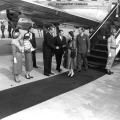ONLINE EXHIBITIONS
H ist für Henkel
(Online Exhibition)
These German-American early printed works are items produced by the Henkel Press, established by two brothers, Solomon and Ambrose, in New Market, Shenandoah County, Va. In 1806. Staying true to their German heritage, many items were available in German or bilingual format, particularly the illustrated primers displayed within. The Henkel family also included several prominent Evangelical Lutheran ministers, as well as entrepreneurs, farmers, and early pharmacists. Their broadsides marketing their own medical products and early printed religious works are also found in this visually striking and informative exhibit with materials held in Manuscripts & Special Collections.
Representation of the Beauty of Nature
(Online Exhibition)
These colorful illustrations, by Benjamin Henry Latrobe (1764-1820), detail the waterways and natural beauty of Virginia, found within his "Essay on Landscape," a two volume sketchbook (1798-1799). He was particularly fond of the James River and sketched it often within these pages. Best known as a premiere architect; Latrobe was also a naturalist and traveler who studied water, rock formation, vegetation and architecture in a variety of Virginian & European settings. His colorful watercolor & pen & ink illustrations complete with exacting descriptions in legible, neatly done penmanship are engaging and honest. His preference was for natural beauty in a landscape. These images provide excellent visual sources for Virginia landscape & culture at the turn of the eighteenth century.
Wheels of Change
(Online Exhibition)
Americans took up cycling in record numbers during the latter half of the 19th century. The invention of the safety bicycle, the bicycle form we know today, allowed more people to ride bicycles with ease. Cycling hit its peak during the 1890s and this period is known as the Bicycle Boom. The Bicycle Boom spurred on societal change through manufacturing, increased mobility, and women's reform. This exhibit explores those changes through illustrations featured in Puck Magazine from 1894 to 1898.
Wonder of Architecture
(Online Exhibition)
Take a tour of classic components of architecture and the realization of these marvels coming together to create some of the world's most iconic buildings in Wonder of Architecture. The beautiful plates in this exhibit are from Encyclopaedia Londinensis, part of the Library's Rare Book Collection. Compiled by John Wilkes of Milland House between 1810 and 1829, this volume explores the mathematical balance and proportion required for many components of architecture, such as the five classical orders of columns. It also depicts the evolution of architectural forms and components, leading finally to plates depicting iconic structures in Europe. St. Paul’s Cathedral, the Parthenon, and Salisbury Cathedral are just some of the notable architectural wonders that can be found.
Botanica
(Online Exhibition)
Take a stroll through our garden! Botanica is an exploration of botanical texts and art through the volumes of the Rare Book Collection at the Library of Virginia. Early herbals which describe plants for their medicinal value (Gerard's Generall Historie of Plantes, 1633 & Salmon's Botanologia: The English Herbal, 1710), textbooks and floras (Elements of Botany by Benjamin Barton Smith, 1804 & Flora Carolinaensis by John Linnaeus Edward Whitridge Shecut, 1806) which study plants scientifically based on their botany and taxonomic relationships. The exhibition also highlights the plant images as art objects that are not only beautiful but portray their subjects faithfully and timelessly.
American Ornithology
(Online Exhibition)
Hand colored engravings of North American birds from American Ornithology by Alexander Wilson (1766-1813). This beautiful set of books, published from 1808 to 1825, is considered the first comprehensive work on American natural history and contains 76 full page illustrations.
Mapping Inequality
(Online Exhibition)
Where you live makes all the difference, but that difference has a history. The current circumstances of Richmond's neighborhoods have roots in state and federal policies that have had lasting effects on concentrations of poverty and growth, lending patterns, homeownership, and educational outcomes for children. Neighborhoods that received a D grade in the 1950s now have a high concentration of federal housing subsidies and high levels of poverty. Children in these same neighborhoods score lower on SOL tests than their peers in neighborhoods with low poverty rates. During the foreclosure crisis, these neighborhoods featured high rates of default. We can use historic and current maps and data to better understand the connection between public policy and economic development in the Richmond region.
WPA Historic Houses Drawings Collection
(Online Exhibition)
The WPA Historic Houses Drawings Collection includes 140 drawings in pen-and-ink, pencil, and watercolor of houses, courthouses, churches, mill houses, and taverns, representing 39 Virginia counties. From 1932 to 1937, the Virginia State Commission on Conservation and Development's Division of History and Archaeology received funds from the Works Progress Administration's (WPA) Federal Art Project to commission five artists—including Rex M. Allyn, Edward A. Darby, Dorothea A. Farrington, E. Neville Harnsberger, and Elsie J. Mistie—to create drawings for a publication on historic Virginia shrines. Although the drawings were never published, likely due to diminishing funds, the collection presents an important record of Virginia architecture, both traditional and vernacular, and includes images of structures that are no longer standing today. The photographs from which the drawings were based are part of the WPA Photograph and Negative Collection at the Library of Virginia.

Queen and Commonwealth
(Online Exhibition)
On October 16, 1957, Queen Elizabeth II and Prince Philip visited Virginia during the commonwealth's 350th anniversary celebration of the founding of Jamestown. Then, as now, the Queen's visit prompted intense interest from the state's people and the media. To mark the 2007 royal visit, the Library of Virginia presented photographs, audio, newspaper accounts, and state records from the 1957 events.


